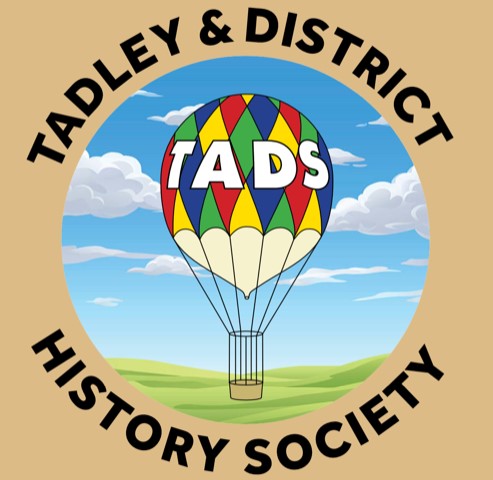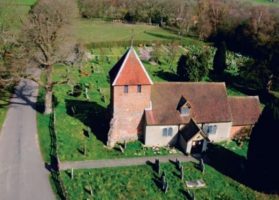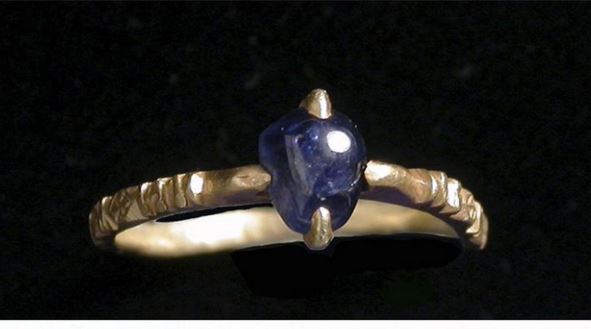Medieval gold ring with a blue stone dating to the late C13th-early C14th
This medieval gold ring with a blue stone dating to the late C13th-early C14th was found in Tadley (location unknown).
The slender highly decorated hoop is divided into many facets creating lozenge fields into which crosses have been engraved, between each faceted lozenge are two vertical bands. The hoop is joined at the bezel by two degenerate dragon’s heads which clasp the blue stone, probably a sapphire. See the article on the Hampshire Cultural Trust website.
This medieval treasure can be seen at the Basingstoke’s Willis Museum

The gold ring was found by metal detector and dates from the late 13th or early 14th century. Courtesy Portable Antiquities Scheme.
A piece of medieval treasure, found by a metal detectorist in 2005, has been acquired by the Willis Museum in Basingstoke.
The gold finger ring, dating from the late 13th or early 14th century, features a blue stone which is thought to be a sapphire and has a highly decorated hoop joined at the bezel by two dragon’s heads, which hold the stone.
After being discovered near Tadley, Basingstoke, the object was taken to a local Finds Liaison Officer, working for the government’s Portable Antiquities Scheme (PAS), who helped to record and catalogue the find. Formal identification by experts at the British Museum followed where it was declared as Treasure Trove, which secured it for the nation.
 The Portable Antiquities Scheme operates across England and Wales. Frank Basford, PAS Finds Liaison Officer for the Isle of Wight, with an Anglo Saxon skillet. © 24 Hour Museum.
The Portable Antiquities Scheme operates across England and Wales. Frank Basford, PAS Finds Liaison Officer for the Isle of Wight, with an Anglo Saxon skillet. © 24 Hour Museum.Under the Treasure Act 1996 finders of gold or silver objects over 300-years old and prehistoric base metal are obliged to report their discoveries, which are subsequently valued at the British Museum and acquired for public display.
Donations from the Friends of the Willis Museum and the Tadley and District History Society have now helped the museum purchase the rare find.
“It was found near Tadley about a year ago but it took quite a while to raise the money to buy it,” said museum curator Sue Tapliss.
“It is on display along with our other medieval objects, which include the Deane Cup, which is a local ‘wow’ object,” she explained. The latter dates from the mid-1500s and was given by Russian Czar Ivan the Terrible to Queen Elizabeth I in 1561.

A PAS Finds Liaison Officer working with metal detectorists in Essex. Courtesy Colchester Museums.
The UK’s largest community archaeology project, the PAS was created in 1997 and every year many thousands of discoveries are made. A national network of Finds Liaison Officers help finders to research and record them.
“The Portable Antiquities Scheme exists to make a record of all archaeological objects found by members of the public,” said Roger Bland, Head of PAS.
“In many cases we just record the objects and return them to the finder but there are a lot of objects we see that should be in a museum and it is always good to see an object acquired by one,” he added.
Thanks to the good work of the PAS, members of the public can enjoy the Willis Museum’s latest acquisition together with other medieval treasures from the local area.


